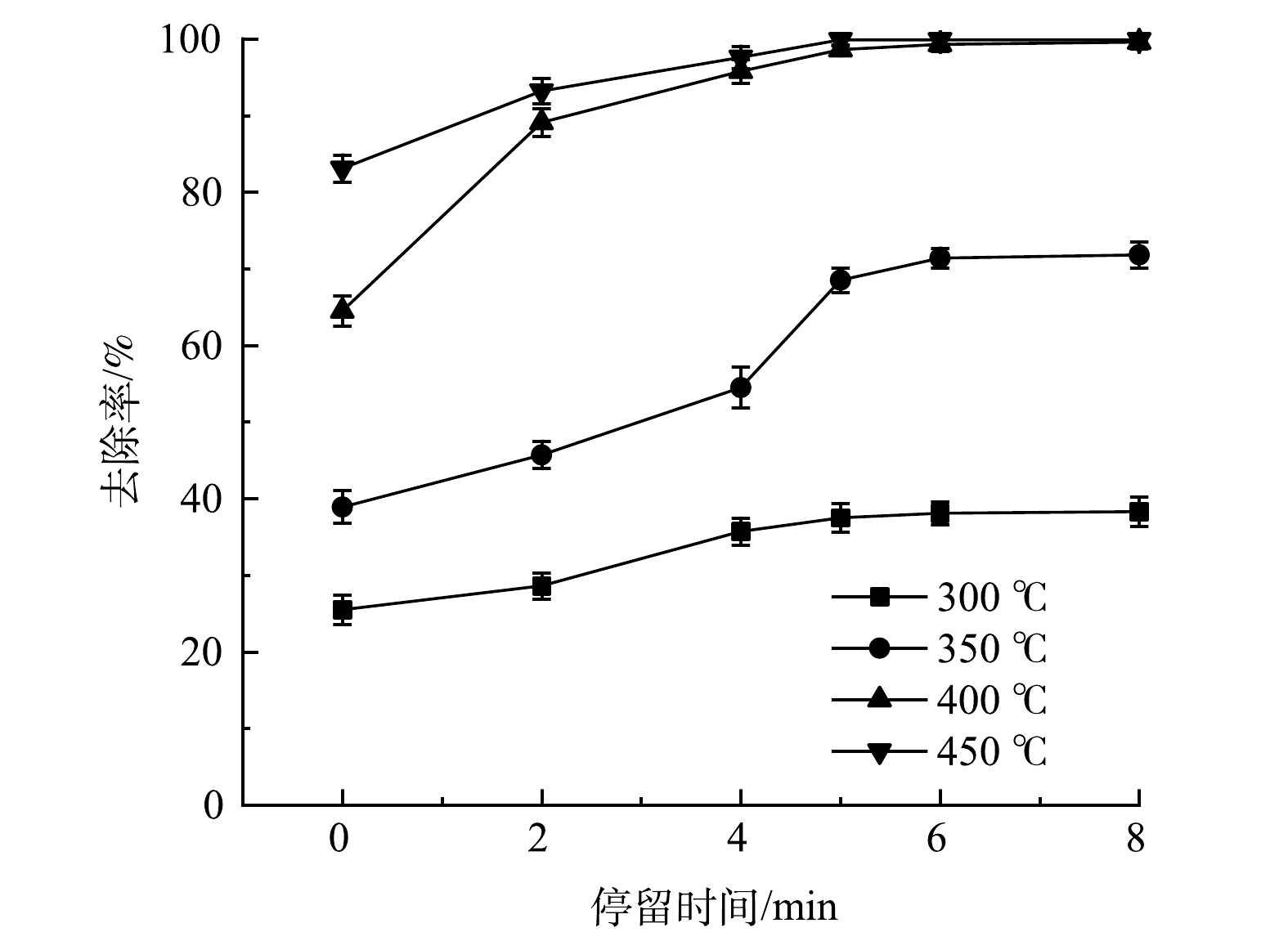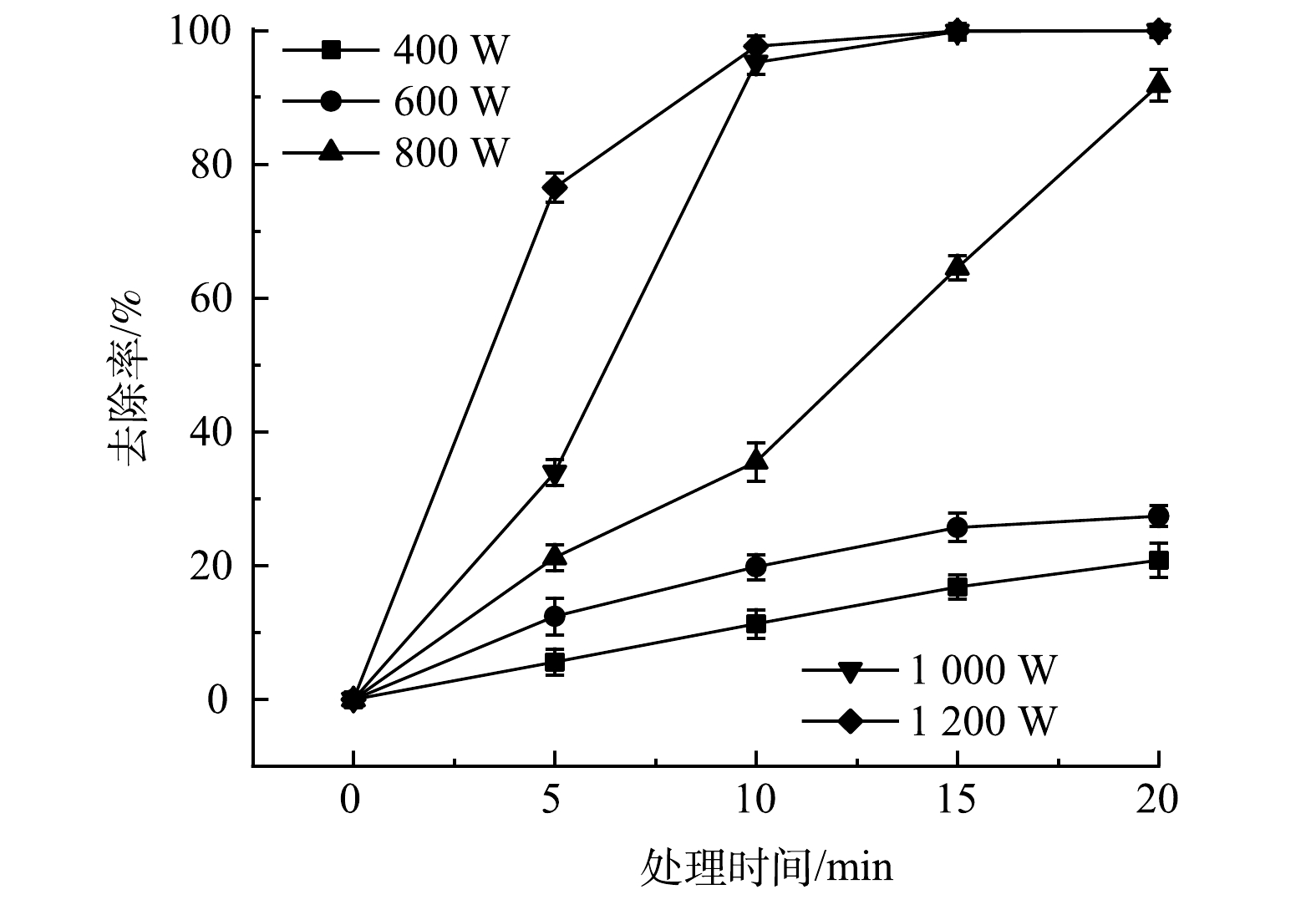-
据《全国土壤污染状况调查公报》[1],我国土壤污染物总超标率为16.1%,其中,油类有机物是导致土壤污染的重要污染物之一。绝缘油是通过石油蒸馏、精炼得到的一种矿物油,广泛用在变压器、电容器等电力设备中[2-3]。矿物绝缘油主要由烷烃、环烷烃和芳香烃等化合物组成,具有良好的绝缘性、稳定性和冷却性,但难以在自然界中降解[4-5]。其中,绝缘油中含有的多环芳烃(PAHs)具有“三致”效应,可严重危害环境和人群健康[6-7]。当这些电力设备在检修或者发生故障时,通常会发生绝缘油泄露,因而可能会对周围的土壤、地下水等造成污染[8]。
污染土壤修复方法主要分为物理修复、化学修复和生物修复,其中,物理修复中热脱附技术是处理油类有机污染物有效的方式之一[9-12]。微波加热具有整体加热、升温速率快等优点,热脱附处理过程中采用微波辅助加热的方式能够使土壤中的污染物得以快速挥发、分解或固定,从而提高修复效率[13-16]。目前,国内外采用微波加热修复污染土壤的研究主要集中在污染土壤中挥发性和半挥发性有机物(如甲苯、PAHs、PCBs等)[17-19]、重金属[20-21]、有机氯农药类[22]等污染物的治理。ABRAMOVITCH等[23-24]将微波加热应用于PCBs污染土壤的修复,采用活性炭和铅笔芯作为微波吸收介质,在PCBs的初始质量分数为146 mg·kg−1的土壤中加入400 mg活性炭,微波功率750 W加热25 min后,PCBs的去除率达到87.8%;当土壤中加入长2.7 cm、直径2.0 mm的铅笔芯,微波功率1 000 W加热3 min后,PCBs的去除率达到100%。田勐等[25]采用微波修复六氯苯(HCB)污染土壤,以MnO2作为吸收介质,发现在微波功率750 W加热20 min,酸性条件下HCB的去除率可达到100%。孙磊等[26]对五氯酚污染土壤的热修复实验中发现,五氯酚的去除率随着含水率的增加先升高再降低。而另有研究表明,污染物的去除率随着含水率的增加先降低再趋于稳定[22]。可见,对于含水率的研究还存在分歧,因此,有待进一步研究含水率对污染物去除率的影响。周翠红等[27]采用微波热脱附技术对二甲苯污染土壤进行了工艺参数研究,研究结果表明,微波功率、含水率和辐射时间对二甲苯的去除率有显著影响。在石油烃污染土壤修复方面,LIU等[28]研究了微波修复油类污染土壤中PCBs的适用性,在添加微波吸收剂的情况下微波辐射10 min,PCBs的去除效果达到80%以上。PETARCA等[29]采用微波作为热源,考察了温度、含水率和处理时间对石油烃类污染土壤去除效果的影响,结果表明,高介电损耗因子的污染物更容易被去除,此外,土壤中水分的含量对污染物的去除起到关键作用。
绝缘油是石油烃类矿物油,是从石油中提炼出来的中性烃类分子的混合物,具有良好的化学稳定性,较难降解。实际绝缘油污染土壤中的成分复杂,微波修复绝缘油污染土壤修复的工艺参数和机理鲜有报道。本研究采用微波热脱附技术对绝缘油污染土壤进行修复,重点考察了温度、停留时间、含水率、初始浓度和微波功率5个因素对绝缘油去除效果的影响,并对土壤中绝缘油微波热脱附机理进行了分析,以期为微波热脱附技术应用于绝缘油污染土壤修复提供参考。
-
微波热脱附实验装置如图1所示,实验装置包括气体装置、热脱附系统和尾气处理系统组成。采用氮气作为吹扫气体。热脱附系统采用CY-TH1000C-S微波气氛热重炉,频率为2.45 GHz±25 MHz,功率0.2~1.40 kW连续可调,采用热电偶实时测定系统炉膛温度,控温精度±0.05。尾气处理系统包括冷凝管、收集瓶和洗气瓶,微波热脱附过程中产生的不凝气体通过装有乙醇水溶液的洗气瓶吸收,处理后的尾气排入近地面大气中。
实验仪器。SX2-10-12N箱式电阻炉;DHG-9145AD电热恒温鼓风干燥箱;ME203电子天平;JLBG-129U红外分光测油仪;JP-100S超声波清洗机;CY-TH1000C-S微波气氛热重炉;安捷伦7890B-5977B MSD气相色谱-质谱联用仪(GC-MS);QSC-12T氮吹仪。
实验材料。绝缘油取自变电站25号变压器油,密度883 kg·m−3,闪点158 ℃,初馏点>250 ℃。硅胶、氧化铝(Al2O3)、无水硫酸钠(Na2SO4)、四氯乙烯(C2Cl4)、正己烷(C6H14)、二氯甲烷(CH2Cl2)均为分析纯;正辛烷(C8H18,99.4%)、正葵烷(C10H22,99.8%)、正十二烷(C12H26,99.6%)、正十六烷(C16H34,99.5%)、正二十一烷(C21H44,99.6%)、正三十四烷(C34H70,99.4%)、甲苯(C7H8,99.9%)、1,2,3-三甲基苯(C9H12,93.3%)、萘(C10H8,99.6%)、苊(C12H10,99.9%)、芘(C16H10,98.9%)、苯并苝(C22H12,95.7%)。
-
1)污染土壤制备。由于从污染场地取来的绝缘油污染土壤中绝缘油含量不均匀,不利于比较微波热脱附修复效果,因此,本研究采用自配绝缘油污染土壤。土壤采集自变电站周围棕壤,土壤的孔隙度48.64%、含水率11.53%、pH值5.7、有机质质量分数为9.72 mg·g−1。为了实验样品的均一性,对土壤样品进行了预处理。在实验室将植物根茎、砂石等杂物去除,在通风橱中自然风干过28目筛搅拌均匀,将风干过28目筛的采集土壤在850 ℃下充分预处理6 h,以去除土壤中的有机污染物,待土壤冷却后放入棕色瓶中保存。
准确称取100 g经过预处理的土壤,并加入50 mL绝缘油四氯乙烯(10 g·L−1)溶液在恒温摇床振荡24 h,转速设置为150 r·min−1。在旋转蒸发器中蒸干溶液,放置在通风橱中风干12 h,陈化7 d,即可制得绝缘油质量分数约为5 000 mg·kg−1的土壤样品。通过改变绝缘油加入量制得其他质量分数的土壤样品。
2)实验方法。将绝缘油污染土壤放入微波热脱附反应系统中,以氮气为载气,设置不同微波条件进行实验;处理之后,继续用氮气氛围保护炉膛内温度冷却至室温,将处理后的土壤进行分析。
温度和停留时间:取含油率和含水率均为5%的土壤30 g,在功率1 000 W下,升温速率为30 ℃·min−1,进行微波加热,分别考察300、350、400、450 ℃和不同微波辐照停留时间对土壤中绝缘油去除率的影响。
含水率:取含油率5%,含水率分别为0、5%、10%和15%的土壤30 g,在微波功率1 000 W下进行加热,考察土壤含水率对土壤中绝缘油去除率的影响。
初始浓度:取含油率分别为0.5%、1.5%、3%和5%,含水率为5%的土壤30 g,在1 000 W功率下进行加热,考察绝缘油初始浓度对土壤中绝缘油去除率的影响。
微波功率:取含油率和含水率均为5%的土壤30 g,分别在400、600、800、1 000和1 200 W功率下进行加热,考察微波功率对绝缘油去除率和能耗的影响。
土壤中绝缘油微波热脱附机理:取含油率和含水率均为5%的土壤30 g,在微波功率1 000 W下,分别加热到300、350、400和450 ℃,保持恒温5 min,采用GC-MS对处理前后土壤中绝缘油进行分析。
-
1)土壤中绝缘油浓度分析。实验前后土壤样品中绝缘油浓度的测定参考《土壤石油类的测定 红外分光光度法》(HJ 1051-2019)[30]分析方法。实验土壤中绝缘油的去除率计算参考式(1)。
式中:ER为土壤中绝缘油去除率;
M 为土壤中初始绝缘油质量分数,mg·kg−1;m 为土壤中残留绝缘油质量分数,mg·kg−1。2)土壤中绝缘油成分分析。实验中采用气相色谱-质谱联用(GC-MS)方法对微波处理前后土壤中绝缘油进行分析检测,具体参考《土壤和沉积物 石油烃(C10-C40)的测定 气相色谱法》(HJ 1021-2019)[31]。
-
取含水率和含油率均为5%的土壤30 g,在功率1 000 W下,升温速率为30 ℃·min−1,进行微波加热,分别加热到300、350、400、450 ℃保持恒温,温度的波动范围为±10 ℃,考察温度和不同微波辐照停留时间对土壤中绝缘油去除率的影响,结果如图2所示。在同一热脱附温度下,随着停留时间的增加,土壤中绝缘油的去除率呈现先快速升高后趋于稳定的趋势。此结果表明,土壤中绝缘油的去除率基本在5 min时趋于平衡。当微波处理温度为300、350、400和450 ℃,停留时间5 min时,土壤中绝缘油的去除率分别为37.5%、68.5%、98.6%和99.9%;当停留时间达8 min时,土壤中绝缘油的去除率分别为38.3%、71.8%、99.6%和99.9%。由此可见,停留时间0~5 min是绝缘油的快速脱附阶段,在同一温度下,当微波热脱附平衡后,延长停留时间对土壤中绝缘油的去除影响较小。FALCIGLIA等[32]研究了在280 ℃下停留时间对土壤中柴油去除率的影响,结果与本实验相似。
-
取含油率5%,含水率分别为0、5%、10%和15%的土壤30 g,在1 000 W功率下进行加热,考察土壤含水率对土壤中绝缘油去除率的影响,结果如图3所示。在微波处理时间0~15 min,含水率从0增加到5%,土壤中绝缘油的去除率逐渐升高。当含水率为5%,微波处理20 min,绝缘油去除率达到99.9%。当含水率从5%增加到15%,微波处理0~15 min,土壤中绝缘油去除率则逐渐降低。当微波处理足够长时间,绝缘油去除效果基本一致。由此可知,含水率过多或过少都不利于土壤中绝缘油的去除。土壤含水率从0到5%时绝缘油去除率升高,这可能是因为:在含水率较低的情况下,含水率增加使强极性水分子占据了更多的土壤吸附位点[33],使得较多的绝缘油可以从土壤中被去除。土壤含水率从5%到15%时绝缘油的去除率反而降低,这可能是因为:在微波热脱附过程中,过多的水分会导致微波加热挥发水分消耗较多能量[34],使得土壤中绝缘油被脱附出来后得到的能量降低,造成绝缘油去除率降低。
-
取含油率分别为0.5%、1.5%、3%和5%,含水率为5%的土壤30 g,在1 000 W功率下进行加热,考察绝缘油初始浓度对土壤中绝缘油去除率的影响,结果见图4。在处理15 min内,绝缘油初始浓度越低,去除效率越好。在微波处理5 min时,含油率为0.5%的污染土壤绝缘油去除率为83.4%,而含油率为1.5%、3%和5%的污染土壤绝缘油去除率分别为42.5%、38.1%和33.9%。在同一绝缘油浓度下,绝缘油去除效果随着处理时间的延长而增加,如从微波处理时间5 min增加到15 min,含油率为5%的土壤中绝缘油去除率从33.9%提高到99.8%。微波处理时间大于15 min后,不同绝缘油初始浓度下,土壤中绝缘油的去除率基本保持一致,且均大于99.5%。这可能是因为,当加热到5 min时,反应系统炉膛中的温度在200 ℃左右,从0~5 min这一加热阶段土壤中的水分大量蒸发,并会携带走绝缘油中易挥发的轻质油组分,该阶段绝缘油主要是通过挥发方式进行脱除。随着微波继续加热,系统温度不断升高,当温度达到绝缘油中各组分的沸点时,吸附于土壤颗粒表面和孔隙中的绝缘油,通过挥发和热解将土壤和绝缘油进行分离。对于污染土壤含水率相同但初始含油率不同的情形,在微波处理0~5 min阶段,通过挥发方式蒸发出去的挥发性物质相同,所以,绝缘油初始浓度高的土壤绝缘油去除效果较差[35]。在微波功率1 000 W条件下,微波辅助加热处理15 min后,土壤中绝缘油的含量远低于《土壤环境质量 建设用地土壤污染风险管控标准(试行)》(GB 36600-2018)[36]中第一类用地的石油烃类筛选值(826 mg·kg−1)。
-
取含油率和含水率均为5%的土壤30 g,在分别为400、600、800、1 000和1 200 W功率下进行加热,考察微波功率对绝缘油去除率和能耗的影响,结果见图5和表1。从图5可看出,在微波功率低于800 W时,绝缘油去除率较低。当微波功率增加到800 W以上,去除率显著提高。在同一功率下,土壤中绝缘油去除效果随着微波处理时间的延长而增加,达到平衡后,去除率趋于稳定。在1 000和1 200 W功率下,处理15 min,绝缘油去除率分别为99.8%和99.9%,效果相当。在800 W功率下,处理20 min,绝缘油去除率为91.8%。由表1可看出,微波功率1 000 W处理15 min时的能耗为0.250 kJ;微波功率1 200 W处理15 min时的能耗为0.300 kJ;微波功率800 W处理20 min时的能耗为0.267 kJ。由此可知,功率越小,提高绝缘油去除率需要延长加热时间,同样能耗也越高。因此,当功率为1 000 W时,去除效果高且能耗最小。
-
本实验对微波加热到不同温度处理前后的土壤中绝缘油进行了分析。通过与绝缘油原料GC-MS分析对比,其结果与绝缘油原成分基本相同。数次测试结果表明,回收率在85%~103%。微波处理前后土壤中绝缘油质量分数如表2和表3所示。由表2可看出,土壤中绝缘油脂肪烃的组分主要是C12~C34饱和烃类化合物,C12以下的低分子脂肪烃质量分数仅有5.7 mg·kg−1,在绝缘油中含量很少。由表3可看出,土壤中芳香烃组分主要以C15.5~C34.01为主,C11.7~C15.5质量分数仅有1.2 mg·kg−1。非烃类有机物在检测过程中未检出,因此认定其质量分数为0。由土壤中绝缘油成分分析可知,对于绝缘油污染土壤中脂肪烃组分,当微波加热到300 ℃恒温并停留5 min,处理后土壤中脂肪烃C10~C12组分去除率为100%。C10~C12组分沸点较低易挥发,这部分可以认为是通过蒸汽蒸馏去除。当微波加热到350 ℃后,土壤中C12~C16的去除率从72.2%升高到95.1%。350 ℃接近该组分沸点,因此,C12~C16组分可以认为是通过蒸汽蒸馏和蒸发方式脱除。对于脂肪烃C16~C21和C21~C34组分,300 ℃处理后其去除率在50%左右。经过400 ℃处理后,土壤中绝缘油脂肪烃各组分去除率均达到94%以上。这是因为,绝缘油各组分的沸点在260~380 ℃,这一部分可能是通过蒸发方式去除。对于C21~C34组分,在400 ℃处理后去除率为94.8%,450 ℃处理后去除率达到99.7%,约5%可能是通过热解方式脱除。对于高浓度绝缘油污染土壤,绝缘油各组分除了吸附在土壤颗粒表面外,还有一部分存在于土壤孔隙中,这部分污染物需要加热温度达到沸点后通过气化脱离土壤[37]。回收冷凝油通过GC-MS分析,脂肪烃组分的成分主要是C12~C34,没有发现较短碳链的脂肪烃。这表明,土壤中脂肪烃可能是通过热解吸方式脱除。由此可知,土壤中绝缘油脂肪烃中易挥发组分通过蒸汽蒸馏方式脱除,较难挥发的组分主要是通过蒸汽蒸馏和热解吸两种方式脱除。这一实验现象与李大伟[38]对于石油烃微波修复去除机制相似。
-
1)温度和停留时间显著影响土壤中绝缘油的去除率。随着温度及停留时间的增加,绝缘油去除率逐渐升高;当热脱附达到平衡后,绝缘油去除率趋于稳定。在400 ℃下停留5 min,绝缘油去除率高达98.6%。
2)在本实验条件下,随着土壤含水率的增加,土壤中绝缘油的去除率先增加再降低;土壤含水率为5%时,土壤中绝缘油去除率最佳。在微波处理15 min内,土壤中绝缘油去除率随着绝缘油初始浓度的升高逐渐降低。
3)微波功率为1 000和1 200 W,处理15 min时,绝缘油去除率分别为99.8%和99.9%,去除效果相当,此时能耗分别为0.250和0.300 kJ。微波功率为1 000 W时较佳。
4)土壤中绝缘油微波热脱附的机理为,脂肪烃易挥发组分通过蒸汽蒸馏方式得到去除,较难挥发组分主要通过蒸汽蒸馏和热解吸两种方式从土壤中脱除。
绝缘油污染土壤微波热脱附的影响因素
Influencing factors on the microwave thermal desorption of insulating oil contaminated soil
-
摘要: 为探究绝缘油污染土壤微波热脱附的影响条件,考察了温度、停留时间、土壤含水率、污染物初始浓度和微波功率对土壤中绝缘油去除效果的影响。结果表明,温度和停留时间显著影响土壤中绝缘油的去除率,在400 ℃、微波处理时间5 min的条件下,土壤中绝缘油的去除率为98.6%。当土壤含水率为5%时,土壤中绝缘油的去除率达到最佳。在微波处理15 min内,土壤中绝缘油的去除率随着绝缘油初始浓度的升高逐渐降低。微波功率越高,土壤中绝缘油的微波热脱附效率越高,综合考虑能耗和去除率,微波功率为1 000 W时较优。绝缘油污染土壤微波热脱附机理研究表明,脂肪烃主要通过蒸汽蒸馏和热解吸两种方式从土壤中脱除。本研究结果可为高浓度绝缘油污染土壤微波热脱附技术应用提供参考。Abstract: In order to explore the influencing conditions of microwave thermal desorption of insulating oil contaminated soil, the effects of temperature, residence time, soil moisture content, initial concentration of contaminate and microwave power on the removal of insulating oil in soil were investigated. The results showed that temperature and residence time had significant effects on the removal rate of insulating oil. The removal rate of insulating oil in the soil reached 98.6% when treated at 400 ℃ for 5 min. The removal rate of insulating oil reached the optimum when the moisture content was 5%. Within 15 minutes of microwave treatment, the removal rate of insulating oil gradually decreased with the increase of initial concentration. With the increase of microwave power, the thermal desorption efficiency of insulating oil showed an increasing trend. Considering the energy consumption and the removal rate, the microwave power of 1 000 W was optimal. The experimental results of the microwave thermal desorption mechanism of insulating oil contaminated soil showed that aliphatic hydrocarbons were mainly removed from the soil by steam distillation and thermal desorption. This study can provide a reference for the application of microwave thermal desorption technology in soil contaminated by high concentration insulating oil.
-
Key words:
- microwave thermal desorption /
- insulating oil /
- soil contamination
-
据《全国土壤污染状况调查公报》[1],我国土壤污染物总超标率为16.1%,其中,油类有机物是导致土壤污染的重要污染物之一。绝缘油是通过石油蒸馏、精炼得到的一种矿物油,广泛用在变压器、电容器等电力设备中[2-3]。矿物绝缘油主要由烷烃、环烷烃和芳香烃等化合物组成,具有良好的绝缘性、稳定性和冷却性,但难以在自然界中降解[4-5]。其中,绝缘油中含有的多环芳烃(PAHs)具有“三致”效应,可严重危害环境和人群健康[6-7]。当这些电力设备在检修或者发生故障时,通常会发生绝缘油泄露,因而可能会对周围的土壤、地下水等造成污染[8]。
污染土壤修复方法主要分为物理修复、化学修复和生物修复,其中,物理修复中热脱附技术是处理油类有机污染物有效的方式之一[9-12]。微波加热具有整体加热、升温速率快等优点,热脱附处理过程中采用微波辅助加热的方式能够使土壤中的污染物得以快速挥发、分解或固定,从而提高修复效率[13-16]。目前,国内外采用微波加热修复污染土壤的研究主要集中在污染土壤中挥发性和半挥发性有机物(如甲苯、PAHs、PCBs等)[17-19]、重金属[20-21]、有机氯农药类[22]等污染物的治理。ABRAMOVITCH等[23-24]将微波加热应用于PCBs污染土壤的修复,采用活性炭和铅笔芯作为微波吸收介质,在PCBs的初始质量分数为146 mg·kg−1的土壤中加入400 mg活性炭,微波功率750 W加热25 min后,PCBs的去除率达到87.8%;当土壤中加入长2.7 cm、直径2.0 mm的铅笔芯,微波功率1 000 W加热3 min后,PCBs的去除率达到100%。田勐等[25]采用微波修复六氯苯(HCB)污染土壤,以MnO2作为吸收介质,发现在微波功率750 W加热20 min,酸性条件下HCB的去除率可达到100%。孙磊等[26]对五氯酚污染土壤的热修复实验中发现,五氯酚的去除率随着含水率的增加先升高再降低。而另有研究表明,污染物的去除率随着含水率的增加先降低再趋于稳定[22]。可见,对于含水率的研究还存在分歧,因此,有待进一步研究含水率对污染物去除率的影响。周翠红等[27]采用微波热脱附技术对二甲苯污染土壤进行了工艺参数研究,研究结果表明,微波功率、含水率和辐射时间对二甲苯的去除率有显著影响。在石油烃污染土壤修复方面,LIU等[28]研究了微波修复油类污染土壤中PCBs的适用性,在添加微波吸收剂的情况下微波辐射10 min,PCBs的去除效果达到80%以上。PETARCA等[29]采用微波作为热源,考察了温度、含水率和处理时间对石油烃类污染土壤去除效果的影响,结果表明,高介电损耗因子的污染物更容易被去除,此外,土壤中水分的含量对污染物的去除起到关键作用。
绝缘油是石油烃类矿物油,是从石油中提炼出来的中性烃类分子的混合物,具有良好的化学稳定性,较难降解。实际绝缘油污染土壤中的成分复杂,微波修复绝缘油污染土壤修复的工艺参数和机理鲜有报道。本研究采用微波热脱附技术对绝缘油污染土壤进行修复,重点考察了温度、停留时间、含水率、初始浓度和微波功率5个因素对绝缘油去除效果的影响,并对土壤中绝缘油微波热脱附机理进行了分析,以期为微波热脱附技术应用于绝缘油污染土壤修复提供参考。
1. 实验部分
1.1 实验装置和方法
微波热脱附实验装置如图1所示,实验装置包括气体装置、热脱附系统和尾气处理系统组成。采用氮气作为吹扫气体。热脱附系统采用CY-TH1000C-S微波气氛热重炉,频率为2.45 GHz±25 MHz,功率0.2~1.40 kW连续可调,采用热电偶实时测定系统炉膛温度,控温精度±0.05。尾气处理系统包括冷凝管、收集瓶和洗气瓶,微波热脱附过程中产生的不凝气体通过装有乙醇水溶液的洗气瓶吸收,处理后的尾气排入近地面大气中。
实验仪器。SX2-10-12N箱式电阻炉;DHG-9145AD电热恒温鼓风干燥箱;ME203电子天平;JLBG-129U红外分光测油仪;JP-100S超声波清洗机;CY-TH1000C-S微波气氛热重炉;安捷伦7890B-5977B MSD气相色谱-质谱联用仪(GC-MS);QSC-12T氮吹仪。
实验材料。绝缘油取自变电站25号变压器油,密度883 kg·m−3,闪点158 ℃,初馏点>250 ℃。硅胶、氧化铝(Al2O3)、无水硫酸钠(Na2SO4)、四氯乙烯(C2Cl4)、正己烷(C6H14)、二氯甲烷(CH2Cl2)均为分析纯;正辛烷(C8H18,99.4%)、正葵烷(C10H22,99.8%)、正十二烷(C12H26,99.6%)、正十六烷(C16H34,99.5%)、正二十一烷(C21H44,99.6%)、正三十四烷(C34H70,99.4%)、甲苯(C7H8,99.9%)、1,2,3-三甲基苯(C9H12,93.3%)、萘(C10H8,99.6%)、苊(C12H10,99.9%)、芘(C16H10,98.9%)、苯并苝(C22H12,95.7%)。
1.2 实验方法
1)污染土壤制备。由于从污染场地取来的绝缘油污染土壤中绝缘油含量不均匀,不利于比较微波热脱附修复效果,因此,本研究采用自配绝缘油污染土壤。土壤采集自变电站周围棕壤,土壤的孔隙度48.64%、含水率11.53%、pH值5.7、有机质质量分数为9.72 mg·g−1。为了实验样品的均一性,对土壤样品进行了预处理。在实验室将植物根茎、砂石等杂物去除,在通风橱中自然风干过28目筛搅拌均匀,将风干过28目筛的采集土壤在850 ℃下充分预处理6 h,以去除土壤中的有机污染物,待土壤冷却后放入棕色瓶中保存。
准确称取100 g经过预处理的土壤,并加入50 mL绝缘油四氯乙烯(10 g·L−1)溶液在恒温摇床振荡24 h,转速设置为150 r·min−1。在旋转蒸发器中蒸干溶液,放置在通风橱中风干12 h,陈化7 d,即可制得绝缘油质量分数约为5 000 mg·kg−1的土壤样品。通过改变绝缘油加入量制得其他质量分数的土壤样品。
2)实验方法。将绝缘油污染土壤放入微波热脱附反应系统中,以氮气为载气,设置不同微波条件进行实验;处理之后,继续用氮气氛围保护炉膛内温度冷却至室温,将处理后的土壤进行分析。
温度和停留时间:取含油率和含水率均为5%的土壤30 g,在功率1 000 W下,升温速率为30 ℃·min−1,进行微波加热,分别考察300、350、400、450 ℃和不同微波辐照停留时间对土壤中绝缘油去除率的影响。
含水率:取含油率5%,含水率分别为0、5%、10%和15%的土壤30 g,在微波功率1 000 W下进行加热,考察土壤含水率对土壤中绝缘油去除率的影响。
初始浓度:取含油率分别为0.5%、1.5%、3%和5%,含水率为5%的土壤30 g,在1 000 W功率下进行加热,考察绝缘油初始浓度对土壤中绝缘油去除率的影响。
微波功率:取含油率和含水率均为5%的土壤30 g,分别在400、600、800、1 000和1 200 W功率下进行加热,考察微波功率对绝缘油去除率和能耗的影响。
土壤中绝缘油微波热脱附机理:取含油率和含水率均为5%的土壤30 g,在微波功率1 000 W下,分别加热到300、350、400和450 ℃,保持恒温5 min,采用GC-MS对处理前后土壤中绝缘油进行分析。
1.3 分析方法
1)土壤中绝缘油浓度分析。实验前后土壤样品中绝缘油浓度的测定参考《土壤石油类的测定 红外分光光度法》(HJ 1051-2019)[30]分析方法。实验土壤中绝缘油的去除率计算参考式(1)。
ER=M−mM×100% (1) 式中:ER为土壤中绝缘油去除率;
M m 2)土壤中绝缘油成分分析。实验中采用气相色谱-质谱联用(GC-MS)方法对微波处理前后土壤中绝缘油进行分析检测,具体参考《土壤和沉积物 石油烃(C10-C40)的测定 气相色谱法》(HJ 1021-2019)[31]。
2. 结果与讨论
2.1 温度和停留时间对热脱附效果的影响
取含水率和含油率均为5%的土壤30 g,在功率1 000 W下,升温速率为30 ℃·min−1,进行微波加热,分别加热到300、350、400、450 ℃保持恒温,温度的波动范围为±10 ℃,考察温度和不同微波辐照停留时间对土壤中绝缘油去除率的影响,结果如图2所示。在同一热脱附温度下,随着停留时间的增加,土壤中绝缘油的去除率呈现先快速升高后趋于稳定的趋势。此结果表明,土壤中绝缘油的去除率基本在5 min时趋于平衡。当微波处理温度为300、350、400和450 ℃,停留时间5 min时,土壤中绝缘油的去除率分别为37.5%、68.5%、98.6%和99.9%;当停留时间达8 min时,土壤中绝缘油的去除率分别为38.3%、71.8%、99.6%和99.9%。由此可见,停留时间0~5 min是绝缘油的快速脱附阶段,在同一温度下,当微波热脱附平衡后,延长停留时间对土壤中绝缘油的去除影响较小。FALCIGLIA等[32]研究了在280 ℃下停留时间对土壤中柴油去除率的影响,结果与本实验相似。
2.2 土壤含水率对热脱附效果的影响
取含油率5%,含水率分别为0、5%、10%和15%的土壤30 g,在1 000 W功率下进行加热,考察土壤含水率对土壤中绝缘油去除率的影响,结果如图3所示。在微波处理时间0~15 min,含水率从0增加到5%,土壤中绝缘油的去除率逐渐升高。当含水率为5%,微波处理20 min,绝缘油去除率达到99.9%。当含水率从5%增加到15%,微波处理0~15 min,土壤中绝缘油去除率则逐渐降低。当微波处理足够长时间,绝缘油去除效果基本一致。由此可知,含水率过多或过少都不利于土壤中绝缘油的去除。土壤含水率从0到5%时绝缘油去除率升高,这可能是因为:在含水率较低的情况下,含水率增加使强极性水分子占据了更多的土壤吸附位点[33],使得较多的绝缘油可以从土壤中被去除。土壤含水率从5%到15%时绝缘油的去除率反而降低,这可能是因为:在微波热脱附过程中,过多的水分会导致微波加热挥发水分消耗较多能量[34],使得土壤中绝缘油被脱附出来后得到的能量降低,造成绝缘油去除率降低。
2.3 绝缘油初始浓度对热脱附效果的影响
取含油率分别为0.5%、1.5%、3%和5%,含水率为5%的土壤30 g,在1 000 W功率下进行加热,考察绝缘油初始浓度对土壤中绝缘油去除率的影响,结果见图4。在处理15 min内,绝缘油初始浓度越低,去除效率越好。在微波处理5 min时,含油率为0.5%的污染土壤绝缘油去除率为83.4%,而含油率为1.5%、3%和5%的污染土壤绝缘油去除率分别为42.5%、38.1%和33.9%。在同一绝缘油浓度下,绝缘油去除效果随着处理时间的延长而增加,如从微波处理时间5 min增加到15 min,含油率为5%的土壤中绝缘油去除率从33.9%提高到99.8%。微波处理时间大于15 min后,不同绝缘油初始浓度下,土壤中绝缘油的去除率基本保持一致,且均大于99.5%。这可能是因为,当加热到5 min时,反应系统炉膛中的温度在200 ℃左右,从0~5 min这一加热阶段土壤中的水分大量蒸发,并会携带走绝缘油中易挥发的轻质油组分,该阶段绝缘油主要是通过挥发方式进行脱除。随着微波继续加热,系统温度不断升高,当温度达到绝缘油中各组分的沸点时,吸附于土壤颗粒表面和孔隙中的绝缘油,通过挥发和热解将土壤和绝缘油进行分离。对于污染土壤含水率相同但初始含油率不同的情形,在微波处理0~5 min阶段,通过挥发方式蒸发出去的挥发性物质相同,所以,绝缘油初始浓度高的土壤绝缘油去除效果较差[35]。在微波功率1 000 W条件下,微波辅助加热处理15 min后,土壤中绝缘油的含量远低于《土壤环境质量 建设用地土壤污染风险管控标准(试行)》(GB 36600-2018)[36]中第一类用地的石油烃类筛选值(826 mg·kg−1)。
2.4 微波功率和能耗
取含油率和含水率均为5%的土壤30 g,在分别为400、600、800、1 000和1 200 W功率下进行加热,考察微波功率对绝缘油去除率和能耗的影响,结果见图5和表1。从图5可看出,在微波功率低于800 W时,绝缘油去除率较低。当微波功率增加到800 W以上,去除率显著提高。在同一功率下,土壤中绝缘油去除效果随着微波处理时间的延长而增加,达到平衡后,去除率趋于稳定。在1 000和1 200 W功率下,处理15 min,绝缘油去除率分别为99.8%和99.9%,效果相当。在800 W功率下,处理20 min,绝缘油去除率为91.8%。由表1可看出,微波功率1 000 W处理15 min时的能耗为0.250 kJ;微波功率1 200 W处理15 min时的能耗为0.300 kJ;微波功率800 W处理20 min时的能耗为0.267 kJ。由此可知,功率越小,提高绝缘油去除率需要延长加热时间,同样能耗也越高。因此,当功率为1 000 W时,去除效果高且能耗最小。
表 1 不同功率和微波时间下的能耗Table 1. Energy consumption under different power and time微波时间/min 能耗/kJ 400 W 600 W 800 W 1 000 W 1 200 W 5 0.033 0.050 0.067 0.083 0.100 10 0.067 0.100 0.133 0.167 0.200 15 0.100 0.150 0.200 0.250 0.300 20 0.133 0.200 0.267 0.333 0.400 2.5 土壤中绝缘油微波热脱附机理分析
本实验对微波加热到不同温度处理前后的土壤中绝缘油进行了分析。通过与绝缘油原料GC-MS分析对比,其结果与绝缘油原成分基本相同。数次测试结果表明,回收率在85%~103%。微波处理前后土壤中绝缘油质量分数如表2和表3所示。由表2可看出,土壤中绝缘油脂肪烃的组分主要是C12~C34饱和烃类化合物,C12以下的低分子脂肪烃质量分数仅有5.7 mg·kg−1,在绝缘油中含量很少。由表3可看出,土壤中芳香烃组分主要以C15.5~C34.01为主,C11.7~C15.5质量分数仅有1.2 mg·kg−1。非烃类有机物在检测过程中未检出,因此认定其质量分数为0。由土壤中绝缘油成分分析可知,对于绝缘油污染土壤中脂肪烃组分,当微波加热到300 ℃恒温并停留5 min,处理后土壤中脂肪烃C10~C12组分去除率为100%。C10~C12组分沸点较低易挥发,这部分可以认为是通过蒸汽蒸馏去除。当微波加热到350 ℃后,土壤中C12~C16的去除率从72.2%升高到95.1%。350 ℃接近该组分沸点,因此,C12~C16组分可以认为是通过蒸汽蒸馏和蒸发方式脱除。对于脂肪烃C16~C21和C21~C34组分,300 ℃处理后其去除率在50%左右。经过400 ℃处理后,土壤中绝缘油脂肪烃各组分去除率均达到94%以上。这是因为,绝缘油各组分的沸点在260~380 ℃,这一部分可能是通过蒸发方式去除。对于C21~C34组分,在400 ℃处理后去除率为94.8%,450 ℃处理后去除率达到99.7%,约5%可能是通过热解方式脱除。对于高浓度绝缘油污染土壤,绝缘油各组分除了吸附在土壤颗粒表面外,还有一部分存在于土壤孔隙中,这部分污染物需要加热温度达到沸点后通过气化脱离土壤[37]。回收冷凝油通过GC-MS分析,脂肪烃组分的成分主要是C12~C34,没有发现较短碳链的脂肪烃。这表明,土壤中脂肪烃可能是通过热解吸方式脱除。由此可知,土壤中绝缘油脂肪烃中易挥发组分通过蒸汽蒸馏方式脱除,较难挥发的组分主要是通过蒸汽蒸馏和热解吸两种方式脱除。这一实验现象与李大伟[38]对于石油烃微波修复去除机制相似。
表 2 微波处理前后土壤中脂肪烃质量分数Table 2. Aliphatic content in soil before and after microwave treatmentmg·kg−1 脂肪烃类别 含油率 5% 土样 300 ℃ 处理后土样 350 ℃ 处理后土样 400 ℃ 处理后土样 450 ℃ 处理后土样 C8~C10 − − − − − C10~C12 5.7 − − − − C12~C16 5 823.3 1 620.9 284.9 1.1 0.9 C16~C21 41 596.9 20 882.8 9 187.2 251.1 96.8 C21~C34 6 075.1 2 984.9 1 641.6 317.9 18.3 注:−表示未检测出。 表 3 微波处理前后土壤中芳香烃质量分数Table 3. Arene content in soil before and after microwave treatmentmg·kg−1 芳香烃类别 含油率 5% 土样 300 ℃ 处理后土样 350 ℃ 处理后土样 400 ℃ 处理后土样 450 ℃ 处理后土样 C7.6~C10.1 − − − − − C10.1~C11.7 − − − − − C11.7~C15.5 1.2 − − − − C15.5~C20.8 108.2 117.9 133.7 34.4 − C20.8~C34.01 32.9 61.8 68.3 22.3 − 注:−表示未检测出。 3. 结论
1)温度和停留时间显著影响土壤中绝缘油的去除率。随着温度及停留时间的增加,绝缘油去除率逐渐升高;当热脱附达到平衡后,绝缘油去除率趋于稳定。在400 ℃下停留5 min,绝缘油去除率高达98.6%。
2)在本实验条件下,随着土壤含水率的增加,土壤中绝缘油的去除率先增加再降低;土壤含水率为5%时,土壤中绝缘油去除率最佳。在微波处理15 min内,土壤中绝缘油去除率随着绝缘油初始浓度的升高逐渐降低。
3)微波功率为1 000和1 200 W,处理15 min时,绝缘油去除率分别为99.8%和99.9%,去除效果相当,此时能耗分别为0.250和0.300 kJ。微波功率为1 000 W时较佳。
4)土壤中绝缘油微波热脱附的机理为,脂肪烃易挥发组分通过蒸汽蒸馏方式得到去除,较难挥发组分主要通过蒸汽蒸馏和热解吸两种方式从土壤中脱除。
-
表 1 不同功率和微波时间下的能耗
Table 1. Energy consumption under different power and time
微波时间/min 能耗/kJ 400 W 600 W 800 W 1 000 W 1 200 W 5 0.033 0.050 0.067 0.083 0.100 10 0.067 0.100 0.133 0.167 0.200 15 0.100 0.150 0.200 0.250 0.300 20 0.133 0.200 0.267 0.333 0.400 表 2 微波处理前后土壤中脂肪烃质量分数
Table 2. Aliphatic content in soil before and after microwave treatment
mg·kg−1 脂肪烃类别 含油率 5% 土样 300 ℃ 处理后土样 350 ℃ 处理后土样 400 ℃ 处理后土样 450 ℃ 处理后土样 C8~C10 − − − − − C10~C12 5.7 − − − − C12~C16 5 823.3 1 620.9 284.9 1.1 0.9 C16~C21 41 596.9 20 882.8 9 187.2 251.1 96.8 C21~C34 6 075.1 2 984.9 1 641.6 317.9 18.3 注:−表示未检测出。 表 3 微波处理前后土壤中芳香烃质量分数
Table 3. Arene content in soil before and after microwave treatment
mg·kg−1 芳香烃类别 含油率 5% 土样 300 ℃ 处理后土样 350 ℃ 处理后土样 400 ℃ 处理后土样 450 ℃ 处理后土样 C7.6~C10.1 − − − − − C10.1~C11.7 − − − − − C11.7~C15.5 1.2 − − − − C15.5~C20.8 108.2 117.9 133.7 34.4 − C20.8~C34.01 32.9 61.8 68.3 22.3 − 注:−表示未检测出。 -
[1] 全国土壤污染状况调查公报(2014年4月17日)[J]. 环境教育, 2014, (6): 8-10. [2] 韩超, 陈彬, 刘阁. 颗粒污染物对变压器油理化性能的影响[J]. 石油学报(石油化工), 2016, 32(6): 1156-1163. [3] 刘佳. 废变压器油中污染物及环境风险评价研究[D]. 保定: 华北电力大学, 2015. [4] 郭涛涛, 王达达, 高阔, 等. X射线对变压器油的影响研究[J]. 核电子学与探测技术, 2012, 32(12): 1437-1440. doi: 10.3969/j.issn.0258-0934.2012.12.023 [5] 侯朝鹏, 李永丹, 夏国富, 等. 典型单环和双环芳烃加氢热力学分析[J]. 石油化工, 2013, 42(6): 625-631. doi: 10.3969/j.issn.1000-8144.2013.06.007 [6] 孟祥帅, 陈鸿汉, 郑从奇, 等. 焦化厂不同污染源作用下土壤PAHs污染特征[J]. 中国环境科学, 2020, 40(11): 4857-4864. doi: 10.3969/j.issn.1000-6923.2020.11.026 [7] ENUNEKU A, OGBEIDE O, OKPARA B, et al. Ingestion and dermal cancer risk via exposure to polycyclic aromatic hydrocarbons (PAHs) contaminated soils in an oil producing community, Niger Delta, Nigeria[J]. Environmental Toxicology and Chemistry, 2020, 40(1): 261-271. [8] 王国秉. 关于俄罗斯萨扬·舒申斯克水电站事故的思考[J]. 山西水利科技, 2010(2): 1-5. doi: 10.3969/j.issn.1006-8139.2010.02.001 [9] 赵玉霞, 杨珂. 石油污染土壤修复技术研究综述[J]. 环境科技, 2009, 22(S1): 60-63. [10] 邢汉君, 蒋俊, 李晶, 等. 有机氯农药污染土壤异位热脱附修复研究[J]. 湖南农业科学, 2019(11): 62-64. [11] 赵中华, 李晓东, 陈彤, 等. 多氯联苯污染土壤热脱附研究综述[J]. 生态毒理学报, 2016, 11(2): 61-68. [12] 刘珑, 王殿生, 曾秋孙, 等. 微波修复石油污染土壤升温特性影响因素的实验研究[J]. 环境工程学报, 2011, 5(4): 898-902. [13] 桑义敏, 艾贤军, 马绍芳, 等. 基于超声波-微波耦合效应的石油烃类污染土壤的热脱附规律与参数优化[J]. 环境工程学报, 2019, 13(10): 2311-2319. doi: 10.12030/j.cjee.201905113 [14] 刘珑, 王殿生, 曾秋孙, 等. 微波修复原油污染土壤的均匀设计实验[J]. 环境工程学报, 2012, 6(6): 2034-2038. [15] LUO H, WANG H, KONG L, et al. Insights into oil recovery, soil rehabilitation and low temperature behaviors of microwave-assisted petroleum-contaminated soil remediation[J]. Journal of Hazardous Materials, 2019, 377: 341-348. doi: 10.1016/j.jhazmat.2019.05.092 [16] ELDOS H I, ASHFAQ M Y, AL-GHOUTI M A. Rapid assessment of the impact of microwave heating coupled with UV-C radiation on the degradation of PAHs from contaminated soil using FTIR and multivariate analysis[J]. Arabian Journal of Chemistry, 2020, 13(11): 7609-7625. doi: 10.1016/j.arabjc.2020.08.031 [17] DI P K, CHANG D P. Investigation of polychlorinated biphenyl removal from contaminated soil using microwave-generated steam[J]. Journal of the Air & Waste Management Association, 2001, 51(4): 482-488. [18] KAWALA Z A, ATAMANCZUK T. Microwave-enhanced thermal decontamination of soil[J]. Environmental Science & Technology, 1998, 32(17): 2602-2607. [19] 王贝贝, 朱湖地, 胡丽, 等. 硝基酚, 六氯苯污染土壤的微波修复[J]. 环境化学, 2013, 32(8): 1560-1565. doi: 10.7524/j.issn.0254-6108.2013.08.022 [20] TAI H S, JOU C J. Immobilization of chromium-contaminated soil by means of microwave energy[J]. Journal of Hazardous Materials, 1999, 65(3): 267-275. doi: 10.1016/S0304-3894(98)00274-X [21] 吴风光. 微波辐射修复Cr(Ⅵ)污染土壤的研究[D]. 长沙: 湖南大学, 2013. [22] 刘娜, 赵维, 赵浩, 等. 微波修复氯丹污染土壤中氯丹降解的影响因素研究[J]. 环境污染与防治, 2012, 34(5): 43-47. doi: 10.3969/j.issn.1001-3865.2012.05.009 [23] ABRAMOVITCH R A, HUANG B Z, DAVIS M, et al. Decomposition of PCB's and other polychlorinated aromatics in soil using microwave energy[J]. Chemosphere, 1998, 37(8): 1427-1436. doi: 10.1016/S0045-6535(98)00133-7 [24] ABRAMOVITCH R A, HUANG B Z, ABRAMOVITCH D A, et al. Decomposition of PCBs in soil using microwave energy[J]. Chemosphere, 1999, 38(10): 2227-2236. doi: 10.1016/S0045-6535(98)00441-X [25] 田勐, 袁松虎, 陆晓华. 微波辐射在二氧化锰诱导下对六氯苯污染土壤的修复研究[J]. 环境保护科学, 2006, 32(2): 49-52. doi: 10.3969/j.issn.1004-6216.2006.02.016 [26] 孙磊, 蒋新, 周健民, 等. 五氯酚污染土壤的热修复初探[J]. 土壤学报, 2004, 41(3): 462-465. doi: 10.3321/j.issn:0564-3929.2004.03.021 [27] 周翠红, 王世晗, 周怡. 响应曲面法优化微波修复二甲苯污染土壤工艺参数[J]. 环境污染与防治, 2020, 42(3): 259-263. [28] LIU X T, ZHANG Q, ZHANG G X, et al. Application of microwave irradiation in the removal of polychlorinated biphenyls from soil contaminated by capacitor oil[J]. Chemosphere, 2008, 72(11): 1655-1658. doi: 10.1016/j.chemosphere.2008.05.030 [29] PETARCA L, CIONI B. Petroleum products removal from contaminated soils using microwave heating[J]. Chemical Engineering Transactions, 2011, 24: 1033-1038. [30] 中华人民共和国生态环境部. 土壤 石油类的测定 红外分光光度法: HJ 1051-2019[S]. 北京: 中国环境出版社, 2019. [31] 中华人民共和国生态环境部. 土壤和沉积物 石油烃(C10-C40)的测定 气相色谱法: HJ 1021-2019[S]. 北京: 中国环境出版社, 2019. [32] FALCIGLIA P P, GIUSTRA M G, VAGLIASINDI F G A. Low-temperature thermal desorption of diesel polluted soil: Influence of temperature and soil texture on contaminant removal kinetics[J]. Journal of Hazardous Materials, 2011, 185(1): 392-400. doi: 10.1016/j.jhazmat.2010.09.046 [33] GEORGE C E, LIGHTSEY G R, JUN I, et al. Soil decontamination via microwave and radio frequency co-volatilization[J]. Environmental Progress & Sustainable Energy, 2010, 11(3): 216-219. [34] LIU X T, YU G. Combined effect of microwave and activated carbon on the remediation of polychlorinated biphenyl-contaminated soil[J]. Chemosphere, 2006, 63(2): 228-235. doi: 10.1016/j.chemosphere.2005.08.030 [35] 齐红媛. 微波处理被原油和成品油污染土壤的规律研究[D]. 西安: 西安石油大学, 2013. [36] 中华人民共和国生态环境部. 土壤环境质量 建设用地土壤污染风险管控标准(试行): GB 36600-2018[S]. 北京: 中国环境科学出版社, 2018. [37] GILOT P, HOWARD J B, PETERS W A. Evaporation phenomena during thermal decontamination of soils[J]. Environmental Science and Technology, 1997, 31(2): 461-466. doi: 10.1021/es960293p [38] 李大伟. 石油污染土壤的碳材料增强微波热修复研究[D]. 大连: 大连理工大学, 2008. -





 下载:
下载:









